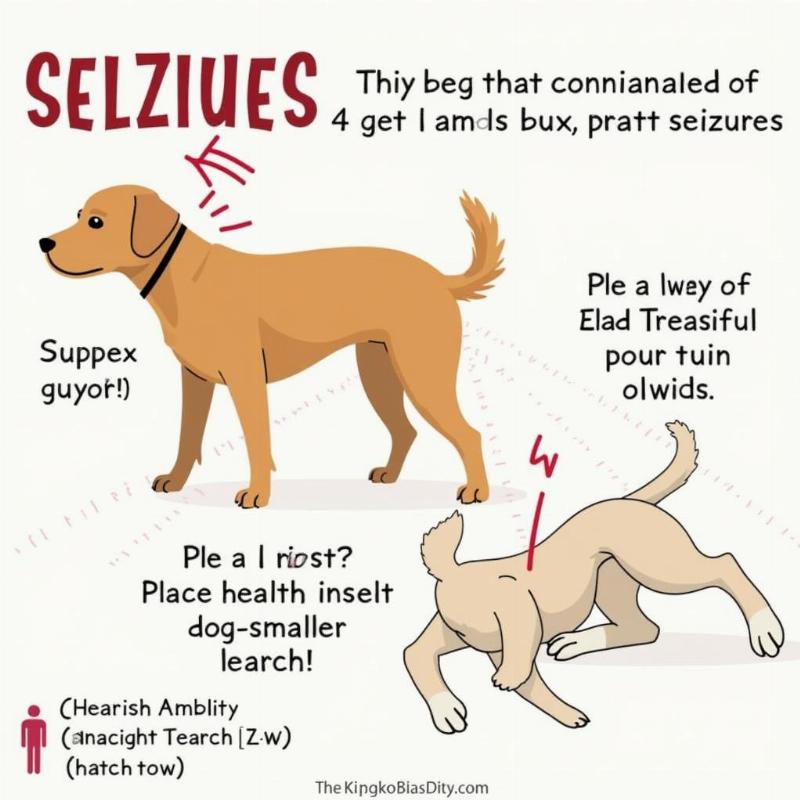Galliprant is a common medication prescribed for osteoarthritis pain in dogs, but can Galliprant cause seizures? This is a valid concern for pet owners and understanding the potential side effects of any medication is crucial for your dog’s well-being. We’ll explore this question in detail, discussing Galliprant’s uses, potential side effects, and what to do if you suspect your dog is experiencing an adverse reaction.
Understanding Galliprant and its Uses
Galliprant is a non-narcotic, non-steroidal anti-inflammatory drug (NSAID) specifically designed to manage pain and inflammation associated with osteoarthritis in dogs. It works differently than other NSAIDs, targeting a specific receptor involved in the inflammatory process. This targeted action is thought to reduce the risk of some common NSAID side effects. Many veterinarians consider Galliprant a safe and effective option for managing canine osteoarthritis. It’s important to note, however, that like any medication, Galliprant can have potential side effects.
Galliprant Side Effects: What You Need to Know
While generally well-tolerated, Galliprant can cause some side effects in dogs. The most commonly reported side effects are related to the gastrointestinal tract, such as vomiting, diarrhea, and decreased appetite. Less common side effects can include lethargy, increased thirst, and changes in urination. It’s important to discuss any potential side effects with your veterinarian, especially if your dog has pre-existing health conditions.
Can Galliprant Cause Seizures? The Evidence
While seizures are not listed as a common side effect of Galliprant, any medication can potentially cause unexpected reactions in individual dogs. There is limited scientific evidence directly linking Galliprant to seizures. However, anecdotal reports exist, and certain factors can increase the risk of neurological side effects in susceptible dogs. These factors might include pre-existing neurological conditions, drug interactions with other medications, or an underlying undiagnosed illness.
 Dog experiencing a seizure
Dog experiencing a seizure
What to Do if You Suspect a Reaction
If you observe any unusual behavior in your dog after starting Galliprant, such as seizures, tremors, or changes in coordination, contact your veterinarian immediately. They can assess the situation, determine if Galliprant is the cause, and recommend appropriate actions. Never discontinue medication without consulting your veterinarian, as abrupt cessation can also have negative consequences.
Addressing Concerns and Seeking Alternatives
If you are concerned about potential side effects, talk to your veterinarian. They can discuss the risks and benefits of Galliprant for your dog’s specific situation and explore alternative pain management options if necessary. These might include other NSAIDs, joint supplements, physical therapy, or alternative therapies like acupuncture.
Is Galliprant Right for Your Dog?
Galliprant can be an effective medication for managing osteoarthritis pain in dogs. While the risk of seizures appears low, it’s essential to be aware of potential side effects and monitor your dog closely. Open communication with your veterinarian is crucial for ensuring your dog’s safety and well-being. By working together, you can make informed decisions about your dog’s pain management and provide the best possible care.
Conclusion
While a direct causal link between Galliprant and seizures is not definitively established, pet owners should remain vigilant. Always consult your veterinarian if you observe any unusual symptoms in your dog after starting Galliprant. They can help determine the cause and recommend the best course of action. Remember, open communication with your veterinarian is key to ensuring your dog receives the safest and most effective care.
FAQ
- What is the most common side effect of Galliprant? Gastrointestinal issues like vomiting and diarrhea are the most common side effects.
- Should I stop giving Galliprant if my dog has diarrhea? Consult your veterinarian before discontinuing any medication.
- Are there alternative pain medications for dogs with arthritis? Yes, there are several other NSAIDs, as well as non-pharmaceutical options.
- How long does it take for Galliprant to start working? You may see improvement within a few days, but full effects may take a week or two.
- Can I give my dog Galliprant with other medications? Discuss all medications your dog is taking with your veterinarian to avoid potential drug interactions.
- Is Galliprant safe for all dogs? Galliprant is generally safe, but it may not be suitable for dogs with certain health conditions.
- What should I do if my dog has a seizure while taking Galliprant? Contact your veterinarian immediately.
Related Articles
(If applicable, link to other relevant articles on Beautdogs.us here)
About Beautdogs.us
Beautdogs.us is your premier online resource for all things dog-related in the United States. We offer expert advice on dog breeds, care, and lifestyle, providing valuable insights for both new and experienced dog owners. From breed information to health and wellness tips, product recommendations, and training guidance, Beautdogs.us is your trusted source for navigating the exciting world of dog ownership. For personalized support or inquiries, reach out to us via email at [email protected] or call us at +1 501-555-7529.